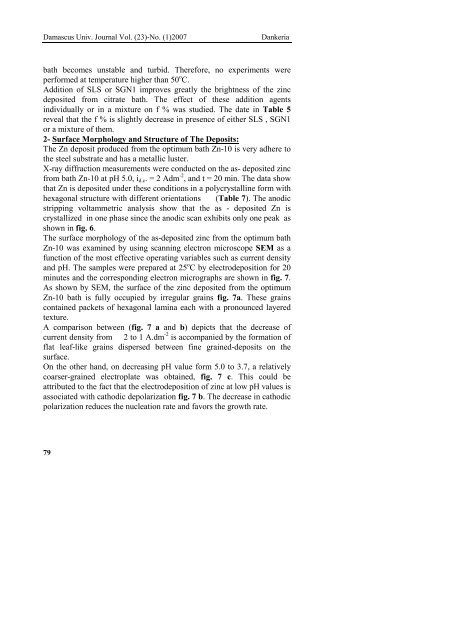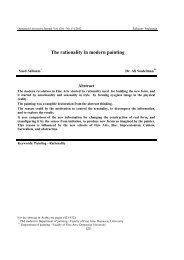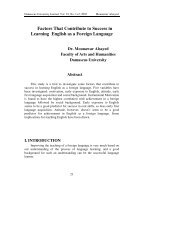"Some Studies on the Parameters for the New Bath for Protection of ...
"Some Studies on the Parameters for the New Bath for Protection of ...
"Some Studies on the Parameters for the New Bath for Protection of ...
Create successful ePaper yourself
Turn your PDF publications into a flip-book with our unique Google optimized e-Paper software.
Damascus Univ. Journal Vol. (23)-No. (1)2007Dankeriabath becomes unstable and turbid. There<strong>for</strong>e, no experiments wereper<strong>for</strong>med at temperature higher than 50 o C.Additi<strong>on</strong> <strong>of</strong> SLS or SGN1 improves greatly <strong>the</strong> brightness <strong>of</strong> <strong>the</strong> zincdeposited from citrate bath. The effect <strong>of</strong> <strong>the</strong>se additi<strong>on</strong> agentsindividually or in a mixture <strong>on</strong> f % was studied. The date in Table 5reveal that <strong>the</strong> f % is slightly decrease in presence <strong>of</strong> ei<strong>the</strong>r SLS , SGN1or a mixture <strong>of</strong> <strong>the</strong>m.2- Surface Morphology and Structure <strong>of</strong> The Deposits:The Zn deposit produced from <strong>the</strong> optimum bath Zn-10 is very adhere to<strong>the</strong> steel substrate and has a metallic luster.X-ray diffracti<strong>on</strong> measurements were c<strong>on</strong>ducted <strong>on</strong> <strong>the</strong> as- deposited zincfrom bath Zn-10 at pH 5.0, i d.c . = 2 Adm -2 , and t = 20 min. The data showthat Zn is deposited under <strong>the</strong>se c<strong>on</strong>diti<strong>on</strong>s in a polycrystalline <strong>for</strong>m withhexag<strong>on</strong>al structure with different orientati<strong>on</strong>s (Table 7). The anodicstripping voltammetric analysis show that <strong>the</strong> as - deposited Zn iscrystallized in <strong>on</strong>e phase since <strong>the</strong> anodic scan exhibits <strong>on</strong>ly <strong>on</strong>e peak asshown in fig. 6.The surface morphology <strong>of</strong> <strong>the</strong> as-deposited zinc from <strong>the</strong> optimum bathZn-10 was examined by using scanning electr<strong>on</strong> microscope SEM as afuncti<strong>on</strong> <strong>of</strong> <strong>the</strong> most effective operating variables such as current densityand pH. The samples were prepared at 25 o C by electrodepositi<strong>on</strong> <strong>for</strong> 20minutes and <strong>the</strong> corresp<strong>on</strong>ding electr<strong>on</strong> micrographs are shown in fig. 7.As shown by SEM, <strong>the</strong> surface <strong>of</strong> <strong>the</strong> zinc deposited from <strong>the</strong> optimumZn-10 bath is fully occupied by irregular grains fig. 7a. These grainsc<strong>on</strong>tained packets <strong>of</strong> hexag<strong>on</strong>al lamina each with a pr<strong>on</strong>ounced layeredtexture.A comparis<strong>on</strong> between (fig. 7 a and b) depicts that <strong>the</strong> decrease <strong>of</strong>current density from 2 to 1 A.dm -2 is accompanied by <strong>the</strong> <strong>for</strong>mati<strong>on</strong> <strong>of</strong>flat leaf-like grains dispersed between fine grained-deposits <strong>on</strong> <strong>the</strong>surface.On <strong>the</strong> o<strong>the</strong>r hand, <strong>on</strong> decreasing pH value <strong>for</strong>m 5.0 to 3.7, a relativelycoarser-grained electroplate was obtained, fig. 7 c. This could beattributed to <strong>the</strong> fact that <strong>the</strong> electrodepositi<strong>on</strong> <strong>of</strong> zinc at low pH values isassociated with cathodic depolarizati<strong>on</strong> fig. 7 b. The decrease in cathodicpolarizati<strong>on</strong> reduces <strong>the</strong> nucleati<strong>on</strong> rate and favors <strong>the</strong> growth rate.79
















